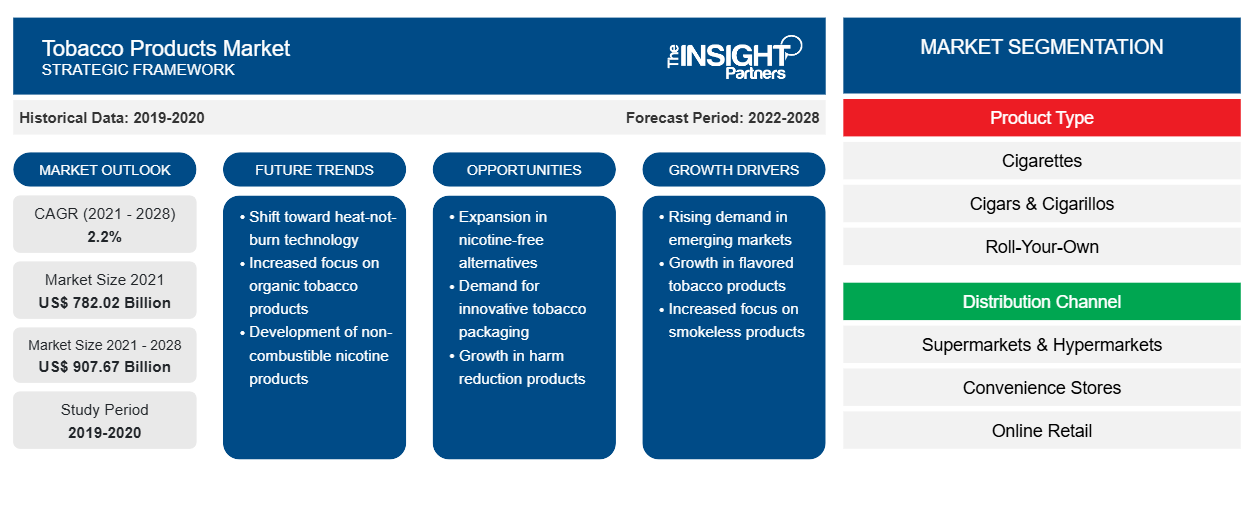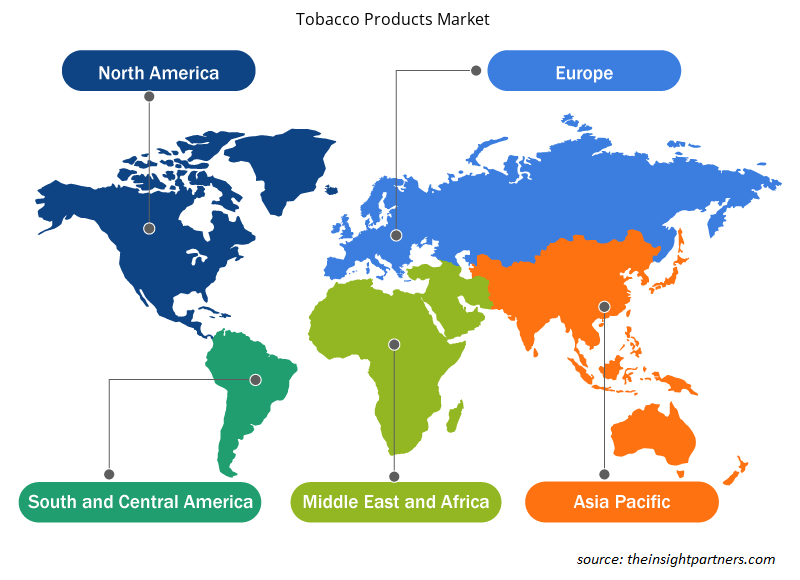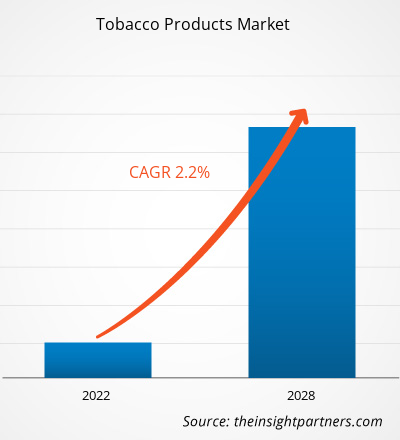The tobacco products market is projected to reach US$ 907,665.43 million by 2028 from US$ 782,022.19 million in 2021. It is expected to grow at a CAGR of 2.2% from 2021 to 2028.
Tobacco leaves of different varieties, such as Virginia and Burley, are blended to manufacture products such as cigarettes, cigars & cigarillos, and roll-your-own tobacco. The consumption of tobacco and related products increased worldwide during the time of economic slowdown owing to the fall in the stock markets and foreclosures, and the stress related to layoffs, which propelled many people to seek refuge through smoking. Tobacco is one of the most common addictive substances used in the world. It also contributes to the majority of the tax revenues for various nations in developed and developing economies.
Asia-Pacific held the largest share of the tobacco products market in 2020, while the Middle East & Africa is expected to register a significant CAGR in the market during the forecast period. The key players operating in the tobacco products market are expanding their operations across the Middle East & Africa owing to the potential customer base, favorable laws, and rapidly developing retail landscape across the region.
Customize This Report To Suit Your Requirement
You will get customization on any report - free of charge - including parts of this report, or country-level analysis, Excel Data pack, as well as avail great offers and discounts for start-ups & universities
Tobacco Products Market: Strategic Insights

- Get Top Key Market Trends of this report.This FREE sample will include data analysis, ranging from market trends to estimates and forecasts.
You will get customization on any report - free of charge - including parts of this report, or country-level analysis, Excel Data pack, as well as avail great offers and discounts for start-ups & universities
Tobacco Products Market: Strategic Insights

- Get Top Key Market Trends of this report.This FREE sample will include data analysis, ranging from market trends to estimates and forecasts.
Impact of COVID-19 Pandemic on Tobacco Products Market
The COVID-19 pandemic brought unprecedented challenges for many sectors in early 2020. Lockdowns, border restrictions, travel bans, manufacturing discontinuation, and other safety measures rolled out by governments as per the guidelines of the WHO and national health ministries hampered the manufacturing operations. On the other hand, according to studies conducted by the American College of Physicians, during the first 16 months of the COVID-19 pandemic, cigarette sales in the US were greater than anticipated. The majority of the tobacco companies witnessed a surge in demand for smokeless or heated tobacco products and chewing tobacco products during the pandemic. However, they faced a slight decline in retail travel sales due to travel bans.
Market Insights
Surging Demand for Noncombustible Tobacco Products Drives Market Growth
Due to the rising health concerns related to the consumption of combustible tobacco products, governments have encouraged companies to introduce several laws and regulations to keep a check on tobacco consumption. They have raised combustible tobacco taxes and lowered noncombustible tobacco prices. This resulted in a greater uptake of noncombustible products, such as e-cigarettes. For instance, the UK government adopted a holistic approach by significantly increasing the taxes on combustible tobacco products and lowering the taxes on noncombustible products. This increased the adoption of e-cigarettes in the UK market, significantly reducing the smoking prevalence rates in the country. Manufacturers have also developed oral, noncombustible, or smokeless tobacco products under the reduced-risk products (RRPs) category.
Product Type Insights
Based on product type, the tobacco products market is segmented into cigarettes, cigar & cigarillos, roll-your-own, and others. The other tobacco products segment is projected to register the highest CAGR during the forecast period. This segment includes e-cigarettes, vapes, snus, and dissolvable. The rising awareness about the harm caused by combustible tobacco products is driving the demand for noncombustible tobacco products, such as e-cigarettes, vapes, and chewing tobacco products.
Distribution Channel Insights
Based on distribution channel, the tobacco products market has been segmented into supermarkets & hypermarkets, convenience stores, online retail, and others. The online retail segment is projected to register the highest CAGR in the market during the forecast period. Online retail offers a convenient shopping experience to users, followed by simplified product delivery. Online retail stores offer a wide range of products at heavy discounts; also, consumers can conveniently buy desirable products remotely. Home delivery services encourage a large number of consumers to shop through e-commerce portals.
The key players operating in the tobacco products market include Altria Group, Inc.; British American Tobacco plc; Swedish Match AB; ITC Ltd.; Japan Tobacco International; Imperial Brands; Philip Morris Products S.A.; Vector Group LTD.; Pyxus International, Inc.; and China Tobacco International (HK) Company Limited. These players are engaged in developing products with reduced health risks to meet the emerging consumer trends, along with abiding by regulatory frameworks. They are involved in mergers and acquisitions, business expansions, and partnerships to expand their market share.
Tobacco Products Market Regional Insights
The regional trends and factors influencing the Tobacco Products Market throughout the forecast period have been thoroughly explained by the analysts at Insight Partners. This section also discusses Tobacco Products Market segments and geography across North America, Europe, Asia Pacific, Middle East and Africa, and South and Central America.

- Get the Regional Specific Data for Tobacco Products Market
Tobacco Products Market Report Scope
| Report Attribute | Details |
|---|---|
| Market size in 2021 | US$ 782.02 Billion |
| Market Size by 2028 | US$ 907.67 Billion |
| Global CAGR (2021 - 2028) | 2.2% |
| Historical Data | 2019-2020 |
| Forecast period | 2022-2028 |
| Segments Covered |
By Product Type
|
| Regions and Countries Covered | North America
|
| Market leaders and key company profiles |
Tobacco Products Market Players Density: Understanding Its Impact on Business Dynamics
The Tobacco Products Market is growing rapidly, driven by increasing end-user demand due to factors such as evolving consumer preferences, technological advancements, and greater awareness of the product's benefits. As demand rises, businesses are expanding their offerings, innovating to meet consumer needs, and capitalizing on emerging trends, which further fuels market growth.
Market players density refers to the distribution of firms or companies operating within a particular market or industry. It indicates how many competitors (market players) are present in a given market space relative to its size or total market value.
Major Companies operating in the Tobacco Products Market are:
- Altria Group, Inc.
- British American Tobacco plc.
- Swedish Match AB
- ITC Ltd.
- Japan Tobacco International
Disclaimer: The companies listed above are not ranked in any particular order.

- Get the Tobacco Products Market top key players overview
Report Spotlights
- Progressive industry trends in the tobacco products market to help players develop effective long-term strategies
- Business growth strategies adopted to secure growth in developed and developing markets
- Quantitative analysis of the tobacco products market from 2019 to 2028
- Estimation of global demand for tobacco products
- Porter's Five Forces analysis to illustrate the efficacy of buyers and suppliers operating in the industry
- Recent developments to understand the competitive market scenario
- Market trends and outlook as well as factors governing the growth of the tobacco products market
- Assistance in the decision-making process by highlighting market strategies that underpin commercial interest, leading to the market growth
- Size of the tobacco products market size at various nodes
- Detailed overview and segmentation of the market, and the tobacco industry dynamics
- Size of the growth in various regions with promising growth opportunities
Frequently Asked Questions
What are the key factors influencing market growth?
The global tobacco products market is primarily driven by the rising consumption of tobacco products in developing regions such as Asia-Pacific and the Middle East & Africa.
Based on product type, which segment is projected to grow at the fastest CAGR in the global tobacco products market.
Based on product type, the other tobacco products segment is projected to grow at the fastest CAGR. Other tobacco products include e-cigarettes & vapes, snus, dissolvable, among others. The growing awareness about the hazardous effects of smoking among consumers is driving the demand for e-cigarettes, vapes, and snus.
Based on distribution channel, which segment held the largest share in the tobacco products market.
Based on distribution channel, the supermarkets and hypermarkets segment held the largest market share owing to high customer traffic in these stores coupled with availability of different brands of tobacco products under one roof.
Which region led the global tobacco products market in 2020?
In 2020, Asia-Pacific led the global tobacco products market owing to the rising number of tobacco consumers across India, China, Japan, among other countries, changing lifestyles of people, increasing disposable income level, and easy available of different brands of tobacco products in the region
What are some entry barriers in the tobacco products market?
The tobacco products market is highly regulated. The manufacturers of tobacco products have to comply with stringent packaging and labeling regulations set by various regulatory bodies across different countries. Moreover, there are few yet dominant market players having strong distribution network and well-established customer base. Further, governments of different nations impose high duties on tobacco products to minimize their consumption. These are some of the entry barriers in the market.
Can you list some of the major players operating in the global tobacco products market?
Some of the prominent players operating in the global tobacco products market include Altria Group, Inc.; British American Tobacco plc; Swedish Match AB; ITC Ltd.; Japan Tobacco International; Imperial Brands; Philip Morris Products S.A.; Vector Group LTD.; Pyxus International, Inc.; and China Tobacco International (HK) Company Limited.
- Historical Analysis (2 Years), Base Year, Forecast (7 Years) with CAGR
- PEST and SWOT Analysis
- Market Size Value / Volume - Global, Regional, Country
- Industry and Competitive Landscape
- Excel Dataset
Testimonials
I wish to appreciate your support and the professionalism you displayed in the course of attending to my request for information regarding to infectious disease IVD market in Nigeria. I appreciate your patience, your guidance, and the fact that you were willing to offer a discount, which eventually made it possible for us to close a deal. I look forward to engaging The Insight Partners in the future, all thanks to the impression you have created in me as a result of this first encounter.
DR CHIJIOKE ONYIA, MANAGING DIRECTOR, PineCrest Healthcare Ltd.The Insight Partners delivered insightful, well-structured market research with strong domain expertise. Their team was professional and responsive throughout. The user-friendly website made accessing industry reports seamless. We highly recommend them for reliable, high-quality research services
Yukihiko Adachi CEO, Deep Blue, LLC.Reason to Buy
- Informed Decision-Making
- Understanding Market Dynamics
- Competitive Analysis
- Customer Insights
- Market Forecasts
- Risk Mitigation
- Strategic Planning
- Investment Justification
- Identifying Emerging Markets
- Enhancing Marketing Strategies
- Boosting Operational Efficiency
- Tracking Industry Innovations
- Aligning with Regulatory Trends
Yes! We provide a free sample of the report, which includes Report Scope (Table of Contents), report structure, and selected insights to help you assess the value of the full report. Please click on the "Download Sample" button or contact us to receive your copy.
Absolutely — analyst assistance is part of the package. You can connect with our analyst post-purchase to clarify report insights, methodology or discuss how the findings apply to your business needs.
Once your order is successfully placed, you will receive a confirmation email along with your invoice.
• For published reports: You’ll receive access to the report within 4–6 working hours via a secured email sent to your email.
• For upcoming reports: Your order will be recorded as a pre-booking. Our team will share the estimated release date and keep you informed of any updates. As soon as the report is published, it will be delivered to your registered email.
We offer customization options to align the report with your specific objectives. Whether you need deeper insights into a particular region, industry segment, competitor analysis, or data cut, our research team can tailor the report accordingly. Please share your requirements with us, and we’ll be happy to provide a customized proposal or scope.
The report is available in either PDF format or as an Excel dataset, depending on the license you choose.
The PDF version provides the full analysis and visuals in a ready-to-read format. The Excel dataset includes all underlying data tables for easy manipulation and further analysis.
Please review the license options at checkout or contact us to confirm which formats are included with your purchase.
Our payment process is fully secure and PCI-DSS compliant.
We use trusted and encrypted payment gateways to ensure that all transactions are protected with industry-standard SSL encryption. Your payment details are never stored on our servers and are handled securely by certified third-party processors.
You can make your purchase with confidence, knowing your personal and financial information is safe with us.
Yes, we do offer special pricing for bulk purchases.
If you're interested in purchasing multiple reports, we’re happy to provide a customized bundle offer or volume-based discount tailored to your needs. Please contact our sales team with the list of reports you’re considering, and we’ll share a personalized quote.
Yes, absolutely.
Our team is available to help you make an informed decision. Whether you have questions about the report’s scope, methodology, customization options, or which license suits you best, we’re here to assist. Please reach out to us at sales@theinsightpartners.com, and one of our representatives will get in touch promptly.
Yes, a billing invoice will be automatically generated and sent to your registered email upon successful completion of your purchase.
If you need the invoice in a specific format or require additional details (such as company name, GST, or VAT information), feel free to contact us, and we’ll be happy to assist.
Yes, certainly.
If you encounter any difficulties accessing or receiving your report, our support team is ready to assist you. Simply reach out to us via email or live chat with your order information, and we’ll ensure the issue is resolved quickly so you can access your report without interruption.















The List of Companies - Tobacco Products Market
- Altria Group, Inc.
- British American Tobacco plc.
- Swedish Match AB
- ITC Ltd.
- Japan Tobacco International
- Imperial Brands
- Philip Morris Products S.A.
- Vector Group LTD.
- Pyxus International, Inc.
- China Tobacco International (HK) Company Limited






 Get Free Sample For
Get Free Sample For